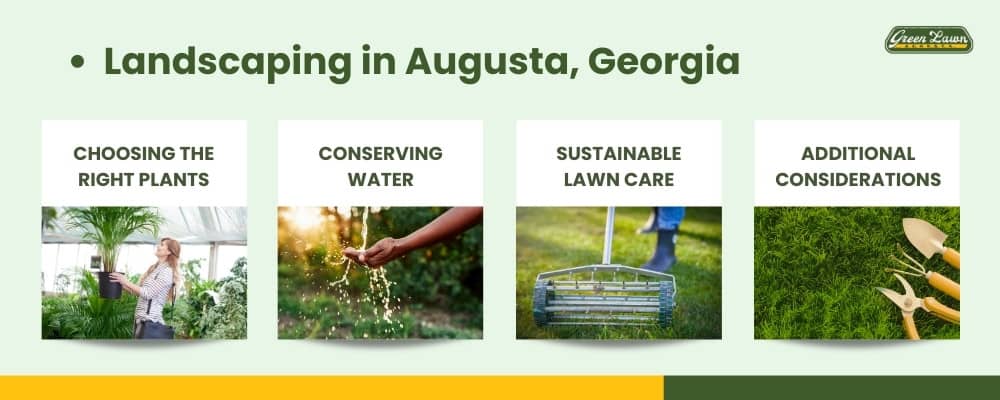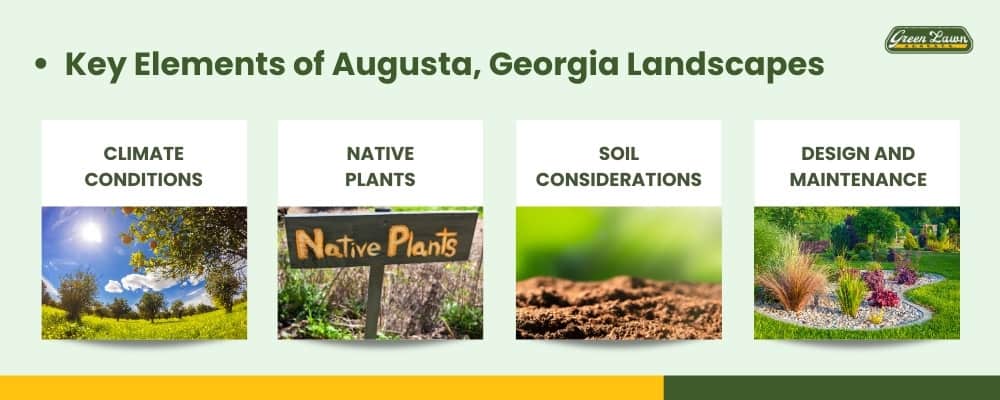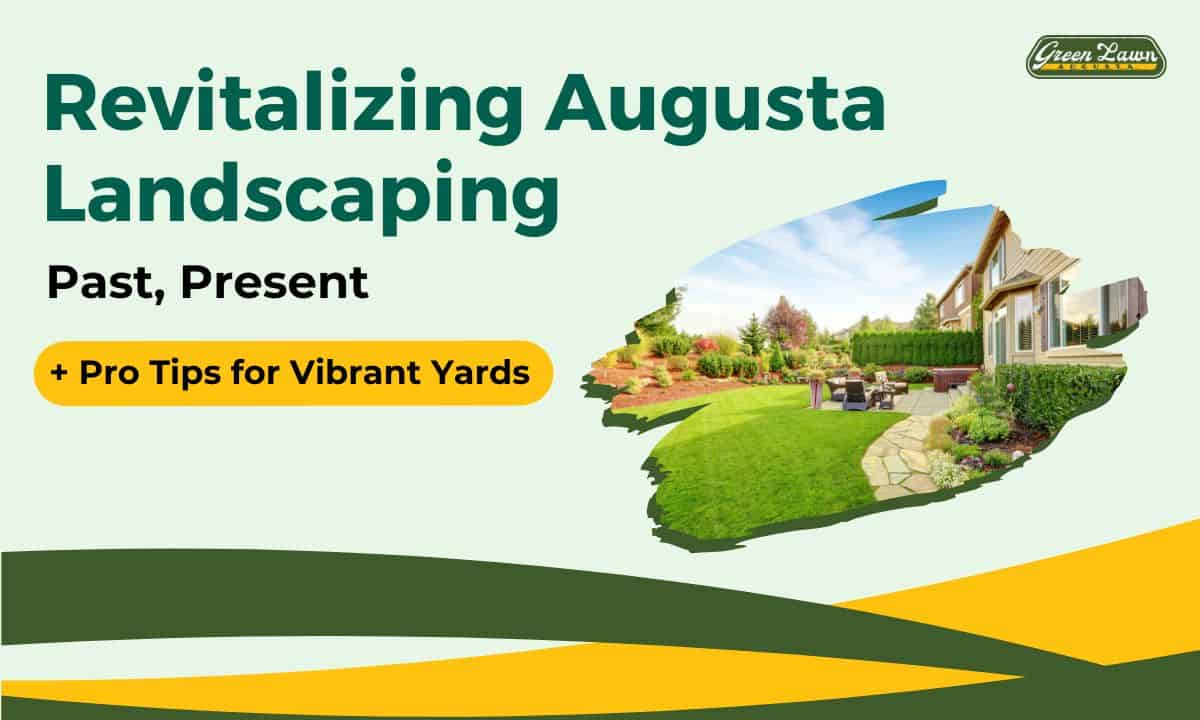You’re one of many Augusta homeowners who want a bright, lively yard. Not sure how to start? No problem! Whether you’re a garden pro or don’t know one plant from another, we’ll help you.
Let’s begin and bring back Augusta’s great gardening history, safe and stunning.
Table of Contents
ToggleLandscaping in Augusta, Georgia

There are a few important things to consider for landscaping in Augusta, Georgia.
First, it’s crucial to pick the right plants. These should look good and thrive in Augusta’s hot, wet climate.
Next, remember to save water and use nature-friendly lawn care practices. This might involve using a smart watering system and opting for natural lawn care products.
Lastly, it’s essential to consider the soil, different types of plants, and where to place them. These factors can significantly impact the success of your landscaping.
Overall, when creating a low-maintenance landscape in Augusta, by carefully selecting appropriate plants, conserving water, and considering soil and plant placement.
Choosing the Right Plants
You must pick the best plants to grow well in Augusta’s hot and humid weather. Focus on choosing plants that are native to Augusta for your garden. Think about things like the type of soil, how much sun the plant needs, and saving water.
Here’s a simple guide:
| Kind | Plant |
|---|---|
| Tree | Live Oak |
| Tree | Magnolia |
| Bush | Camellia |
| Grass | Muhly grass |
| Vine | Carolina Jessamine |
These garden plants for Augusta’s weather add color and shape and need less water. So, when picking the best plants, choose those that can grow well with less water. This way, you’ll keep a bright garden while saving Augusta’s important resources.
Conserving Water
To save water, there are several methods you can consider:
- Changing soil: By improving the quality of your soil, you can increase its water-holding capacity and reduce the need for frequent watering.
- Mulching: Adding a layer of mulch around your plants can help retain moisture in the soil, reducing water evaporation and the need for constant watering.
- Using local grasses: Opting for grass varieties native to Augusta that can withstand dry conditions can greatly reduce water consumption in your landscaping.
- Setting up drip watering systems: Installing drip irrigation systems can deliver water directly to the roots of plants, minimizing water waste through evaporation or runoff.
Saving water in Augusta landscaping involves more than just reducing water usage. It also entails creating a resilient garden that thrives in Augusta’s climate.
One approach to consider is xeriscaping, which involves selecting plants that can survive with minimal water requirements, thus reducing the need for frequent watering.
Another effective strategy is rain garden design. By collecting rainwater in barrels, you can obtain a free water source for irrigation while mitigating runoff, which helps conserve water.
Sustainable Lawn Care
For a better, greener lawn, think about using sustainable care methods. Environmentally friendly lawn care in Augusta is all about helping your lawn while protecting the environment.
Here are four easy steps:
- Core Aeration and Soil Testing: These steps help your grass get the right nutrients.
- Organic Fertilizers: In Augusta, avoid strong chemicals for your garden.
- Longer Grass Lengths: This keeps the soil cool and saves water.
- Manual Pest Control: Use hands-on methods to keep pests away without harmful toxins.
With green landscaping in Augusta, mowing, aerating, and fertilizing can help your lawn look and feel better. It’s not just about looking good; it’s about making a safe, green space for everyone to enjoy.
Additional Landscaping Considerations
When starting a landscaping project in Augusta, there’s more to think about than just earth-friendly lawn care. Local rules, soil type, and ideas from nearby gardens are key extra landscaping aspects to remember.
| Aspect | Why It’s Important |
|---|---|
| Rules | They guide things like fences and managing stormwater. |
| Soil Type | It helps decide what plants to choose and improves soil. |
| Nearby Gardens | They give design ideas. |
| Expert Help | It’s good to get for tricky projects. |
| Upkeep | It helps decide what plants to choose and improves the soil. |
Knowing these parts keeps you following the rules and ensures your landscape flourishes in Augusta’s special setting.
Here are some hints for landscaping in Augusta: stick to local styles, look at current landscaping trends in Augusta, get an expert for complex designs, and always keep up with maintenance.
Now let’s talk about the main parts of Augusta landscapes.
Key Elements of Augusta, Georgia Landscapes

When learning about landscaping in Augusta, Georgia, it’s important to know the special features that shape local gardens.
You should consider the area’s weather, as it impacts your choice of local plants and the soil they need to grow best.
Also, knowing how these things affect good garden design and care can help you have the right information to make a lively and lasting landscape.
Climate Conditions
When planning your Augusta garden, think about the hot, sticky summers and gentle winters. Gardening in Augusta can be tricky but also fun.
Here are 4 simple tips for good gardening in this weather:
- Picking Plants: Pick plants that can handle the heat and dampness, like Augusta’s dry-loving plants.
- Using Water: There’s only a bit of rain, so you’ll need a good watering system to keep your garden green.
- Preparing the Ground: Knowing how to work with Augusta’s ground is key for healthy plants.
- Taking Care All Year: Garden care changes with the seasons because of changing temperatures.
Native Plants
Adding local plants like red maples, river birches, and Sweetbay magnolias can strengthen your garden against weather changes. These plants are key to making gardens in Augusta, GA, beautiful because they’re tough and can adjust to different conditions.
Oakleaf hydrangeas, Virginia sweetspire, and sumac are bushes that add color and make your garden’s environment more secure. If you want native flowers in your Augusta garden, think about wildflowers like black-eyed Susans, coneflowers, and lantana. They attract insects that help grow your garden even more.
Soil Considerations
Looking at your garden’s soil is essential. It’s not just about picking plants that do well in Augusta’s weather but ensuring they fit your unique soil. When fixing up an Augusta garden, start with a soil test.
Here are four simple steps for the best outcome:
- Do a ‘soil test for landscaping in Augusta’ at a local lab.
- Based on the results, pick the right plants, like clay or sandy loam.
- Follow ‘fertilizing rules for Augusta lawns’ using natural compost to help with drainage and nutrients.
- Think about plants that can handle dry conditions in sandy areas.
Design and Maintenance
Designing a good garden and keeping it clean and tidy go together. In Augusta gardening, you must know about the local weather, plant types, and safety rules.
Having a good lawn care plan for Augusta is key. This includes doing things at certain times of the year, like using fertilizer in spring and fall, controlling pests in summer, or cutting back plants in Augusta Gardens when needed.
Maintenance helps your garden stay healthy and keeps it looking nice. Remember, every good garden comes from regular care and attention to small details.
Now that you understand the basics of maintenance let’s talk about how to make a garden plan for Augusta in the next section.
Developing an Augusta Landscape Plan

You must first check your yard’s details and conditions to make a garden that does well in Augusta’s special weather. It’s key to pick the right plants that look good and fit your yard’s sunlight, soil, and water needs.
Thinking about being eco-friendly, think about getting help from expert garden workers. They can help you plan a garden that is easy to care for and good for the environment. They can also help with regular care to keep your yard looking great all year.
Assess Your Yard
Before starting big gardening tasks, you need to understand your yard well. Here are some steps to help you:
- Look at what’s already there: See your yard’s plants, water systems, and lights. Are they the best ones for yards in Augusta?
- Spot small weather zones: Sunlight and soil changes can make small areas with different weather in your yard.
- Test your soil: Knowing what’s in your soil and how much food it has for plants is key to good planting.
- Learn about bugs and diseases: Learn about common Augusta yard bugs and lawn sickness to avoid future issues.
Select Appropriate Plants
Picking the right plants for your yard is about more than just looks. It’s also about what will grow best in your specific soil and weather conditions.
History shows that local species like trees, bushes, grasses, and flowers work best in Augusta. They’re used to the local weather and soil, an important point in many Augusta landscaping studies.
Taking care of your garden during different seasons in Augusta also matters. Some plants bloom nicely in one season but may stop growing or even die in another if not taken care of properly.
Always remember how big plants get when they grow; you don’t want your yard to get too crowded.
Design for Sustainability
Once you’ve picked the right plants, let’s focus on making your Augusta garden sustainable.
Think about these four key points:
- Use plants that can survive drought: These plants need less water and do well in local weather. This cuts down on your work.
- Use drip watering: This method saves water by giving it straight to the plant roots.
- Create rain gardens: These can handle rainwater runoff, provide a home for wildlife, and make your garden look nicer.
- Choose organic lawn care: This includes lawn aeration, which has many benefits in Augusta, like better water absorption and healthier grass.
Each of these parts helps the environment and makes a safer outdoor area with less maintenance.
Hire Landscape Professionals
Think about hiring landscaping experts for your big garden projects. They are experts at making designs that fit local weather and rules. They can turn your ideas into real plans, ensuring everything is safe and looks good.
Landscape architects are like the bosses of bright yards, while landscape workers make those plans come true. They follow the design rules closely and do their work with accuracy. This cuts down on problems that could happen with bad installs.
Local plant shops can give you many tips about plants that do well in Augusta’s climate. Their advice helps you choose plants that not only grow well here but also help keep your yard balanced with nature. Using their knowledge makes sure your landscape stays beautiful for a long time.
Schedule Ongoing Care
Taking care of your Augusta garden regularly is key. This helps keep your garden healthy and long-lasting. Adjusting to weather shifts and quickly fixing any problems helps protect your garden.
This lets you have a bright, lively yard all year round.
1) Mowing: Mowing often keeps the grass in top shape, stops pests, and makes grass grow thick.
2) Pruning: Cutting plants often keeps them in good shape and stops them from growing too much.
3) Pest Control: Regular checks for pests keep them away. If pests are seen, treat them right away to stop harm.
4) Fertilization: Fertilizers made for specific plants give vital nutrients that help strong growth.
Conclusion
When you look at your Augusta yard, picture rich azaleas, tall pines, and bright dogwoods.
You know the old and new ways of landscaping cost analysis plan for our special weather and soil.
Now, turn these expert tips into work. Taking time is important – your dream Southern garden won’t pop up fast.
So, get your garden gloves, start digging, and begin making your piece of Augusta heaven today!

